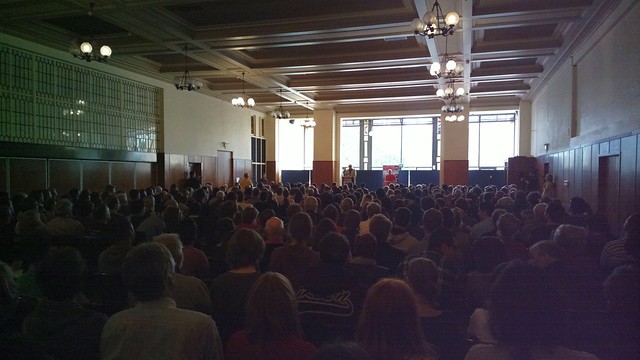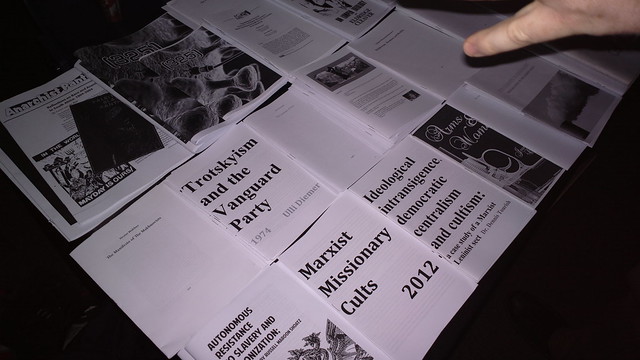“The very revolutionaries who claim that they are against the state, and for eliminating the state…see as their central task after a revolution to build up a state that is more solid, more centralized and more all-embracing than the old one.” – Ron Taber, 1988 (1).
By Mitch
The remarkably common attitude among revolutionaries of all stripes is that “the means justify the ends”. We’re told it is acceptable to embrace authoritarian organisational practices because these practices are necessary to achieve an anti-capitalist revolution. As Anarchists we argue that the theory and organisational practice of revolutionary groups must be consistent with the principles upon which we want a future society to be based. We believe that the praxis of groups which seek communism should point them toward communism, and not toward statism, authoritarianism, hierarchy, and centralism. This is not mere idealism, the cold hard fact is that “ends” do not justify “means”, rather “means create ends”. Revolutionaries that embrace “means” that are in contradiction with the kind of society they wish to create will consistently fail to create that society.
Amongst Marxist-Leninist political tendencies the contradiction between means and ends starts with the idea of the vanguard party as the vehicle for social change. The vanguard party is supposed to be comprised of the most enlightened and class-conscious members of the working class. In practice, the vanguard party begins as a self-selecting minority. It seeks to draw in the most militant elements of the working class, but its structure remains centralised and authoritarian. This minority occupies centralised leadership positions and directs the political activity, strategy and tactics of the party. Whether or not there is real democratic accountability within the vanguard party on some intermittent basis, the vanguard party is a command structure in which decisions are made by a minority, and the majority is expected to put the plans and desires of the leadership into action.
The end goal of the vanguard party is to prosecute a revolution and achieve control of a ‘workers’ state’. During a transitional period between capitalism and communism called, ‘the dictatorship of the proletariat’, the vanguard would utilise this authoritarian, hierarchical, and centralised state, in order to coordinate the running of society.
The structure of the vanguard party prefigures the structure of the workers’ state after the revolution, but it does not achieve the directly democratic communist society it claims to aspire toward. As a centralised minority, the party would have gained control over all the working class in a society. The same working class that historically and necessarily did the grunt-work to bring the revolution to that point.
Vladimir Lenin himself said, “a party is the vanguard of a class, and its duty is to lead the masses and not merely to reflect the average political level of the masses” (2).
According to Leninists, the vanguard party is necessitated by the idea that the working class is too burdened by ‘the muck of ages’ to emancipate itself, for itself. This means that the ruling ideas of capitalism plague people’s ability to be satisfactorily class conscious. These ruling ideas include sexism, racism, homophobia, and nationalism.
This is the historically-selective and pessimistic base on which the enlightened vanguardists decide that their party is necessary.
Yet the vanguard, who set out on a convoluted road which is ‘diametrically opposed to communism’ are plagued by some muck of their own (3). The latent authoritarian and hierarchical nature of the capitalist state remain as unchecked cornerstones of the workers’ state.
As Murray Bookchin argued in ‘Listen, Marxist’, ‘…the deep-rooted conservatism of [so called] “revolutionaries” is almost painfully evident; the authoritarian leader and hierarchy replace the patriarch and the school bureaucracy; the discipline of the Movement replaces the discipline of bourgeois society; the authoritarian code of political obedience replaces the state; the credo of “proletarian morality” replaces the mores of puritanism and the work ethic. The old substance of exploitative society reappears in new forms, draped in a red flag, etc…’ (4).
Classical Marxist and Leninist analyses of the state fail to acknowledge the way that assuming state power changes any ‘workers’ who do so. Contrary to what Marx argued, workers cease being workers when they take control of a state. They become self-appointed managers of workers, and so they cement themselves as a new managerial class, entirely distinct from the working class.
Mikhail Bakunin was correct when he argued that the ‘workers state’, “will consist of ex-workers. And from the heights of the State they begin to look down upon the whole common world of the workers. From that time on they represent not the people but themselves” (5).
It’s a perversion and a contradiction of the politics that originate these theories that workers should die in droves to overthrow thousands of bosses and replace them all with one boss — the state. Especially when this boss conceals its class status; cloaks itself in the guise of a fellow worker, of a comrade. It deviously calls itself a worker and not a manager of workers to justify its authority.
Leon Trotsky was right when he complained of Stalinism that, “In a country where the sole employer is the State, opposition means death by slow starvation. The old principle: who does not work shall not eat, has been replaced by a new one: who does not obey shall not eat” (6). It is ironic that he saw no contradiction in this state of affairs when he was so intimately involved in constructing Russia’s one party state.
It seems the over-worked proletariat is destined to remain the over-worked proletariat but a few enlightened workers graduate to a privileged position where they coordinate what work will be done, by whom, and by when. The creativity, initiative, and the ideas the emancipated working class have for the new society are apparently disposable in the eyes of Marxists. At least, they’re not worth as much as the ideas of the vanguardists who make the familiar and misguided claim that they know what’s right for people better than people do themselves.
It is evident that the praxis of vanguardists doesn’t prefigure anything beyond their own ascent to power. After they have gained power, the so-called ‘withering away’ of the workers’ state is a barely developed and meaningless sentiment based on the false idea that no classes would exist after workers (read: ex-workers turned administrators of workers) take power. This means that the fixed state institutions; its armies; its centralised networks of production; its education and media facilities that fill the society with the state’s own ideas, would magically disappear with the abolition of class.
The workers’ state won’t and can’t wither away. All ruling minorities have an interest in maintaining their position as such. A newly installed ruling minority will use its power and authority to further justify and entrench its own power and authority. It will have under its thumb a monopoly over the legitimate use of violence in a society, which has historically been used to give the workers’ state the authority to eliminate the state’s non-reactionary dissenters. Instead of encouraging the expression of ideas for the betterment of society from all who make up that society, the workers’ state creates itself with its own elitism and belief in the superiority of the ideas of the ruling vanguard. This is a fundamental part of the praxis leading to it. In order to maintain its rule, the so-called workers’ state will actively combat any opposing ideas with propaganda through the centralised control of media outlets and educational facilities, if not with direct force.
Fabbri notes that the state has ‘bureaucratic, military and economic foundations…’ and that ‘…in a short space of time what one would have would not be the state abolished, but a state stronger and more energetic than its predecessor and which would come to exercise those functions proper to it – the ones Marx recognised as being such – “keeping the great majority of producers under the yoke of a numerically small exploiting minority”’ (3).
Anarchists argue that while a revolutionary force is being built to smash the capitalist state, we must also be building the kinds of prefigurative institutions that will make libertarian socialism possible. Our task is to argue for and build a practice of neighbourhood, community, and workers councils. The alternative to a vanguard party is the creation of federations of participatory democratic bodies, outside the control of this or that political faction. To the greatest extent possible, before, during, but most importantly, after a revolution, these directly democratic, horizontal, and decentralised institutions must replace the centralised, state-run equivalents. In this way, anarchists seek to build the embryo of communism within the capitalist system, with the aim of both providing for the people where the state can’t, and of building the new world in the shell of the old.
When the capitalist state is smashed by the popular uprising, these decentralised institutions and councils can continue functioning, and any remaining useful functions of the state become coordinated by further federated councils of workers and regular people. If we have built the practice of participatory democracy, a centralised workers’ state is never required.
Of course, there would be the need to defend the revolution, and to this end anarchists argue for a people’s militia ‘rooted in workplaces and communities… and directed overall by the federation of councils [would] enforce its will against armed counterrevolution or foreign invasion,’ according to Wayne Price (7).
If we are opposed to the domination of a ruling class, clique or party, we must build a libertarian socialism that involves the participation of the mass of society in the process of decision making, economic coordination, and military defence.
The partisans of the ‘workers’ state’ and the vanguard party have a revolutionary program committed to anything but communism. Given they propose a society where power and initiative are both necessarily centralised features belonging only to the state and not to every person equally, they are not creating the necessary basis for communism, but rather totalitarianism.
Anarchists wish to create a society where no one person can exploit another for their own gain, and so the stepladder to power that is the state must be knocked over so that it can’t be reassembled — Not left to stand, and certainly not used to govern with a pessimistic fear that the people necessary to the revolution’s success are incapable of creating a new society through their own organising efforts.
Further reading:
(1) Taking a Critical Look at Leninism by Ron Taber.
(2) Speech on the Agrarian Question November 14 by Vladimir Lenin
(3) The Poverty of Statism: Anarchism vs Marxism.
(4) Listen, Marxist! by Murray Bookchin
(5) Marxism, Freedom and the State by Mikhail Bakunin.




